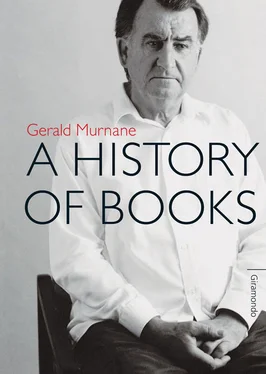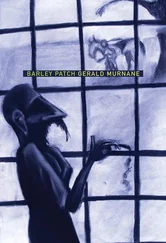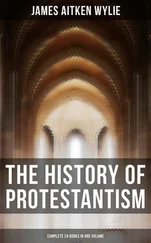The explanation for the strangeness of the image-sky and of the whole image-landscape, according to the owner of the book mentioned, was that sky and landscape were images not of any sight seen by persons in the place called the real world but of visions, so to speak, appearing, so to speak, to the inhabitants, whoever they might be, of the place sometimes called the next world. How else, so the owner of the book argued — how else to explain the appearance in each of the zones of bright image-light in the image-landscape of an image-racehorse with an imagejockey up, so to speak, each racehorse and each jockey having flourished, so to speak, at some or another different period during the past two hundred and more years?
The title of the painting that had been reproduced in the book mentioned was Immortals of the Turf , so the owner of the book told the man beside him while the two men sat and stared at one after another image-racehorse in one after another zone of image-light on the image-grassland mentioned. The name of the painter, according to the owner of the book, meant nothing to him, although he assumed that she was a living Englishwoman, given that the painting had been done only ten years before, that each image-horse had the name of an actual horse that had been bred and had raced in England, and that the foreground of the image-landscape might have seemed to some persons to resemble part of the actual landscape known as Newmarket Heath.
The two men mentioned met often at one or another race meeting in one or another suburb of Melbourne, although they rarely visited each other. During his rare visits to the substantial home with the glass-fronted cabinets, the visiting man spent much time looking into the collection of large illustrated books kept in the cabinets, all of which books were about horse-racing. The visiting man owned perhaps five hundred mostly paperback books of fiction, which books stood on shelves that he had fitted to a wall in the lounge room of the house where he lived with his wife and their children in a certain outer suburb of Melbourne. He and his wife had agreed soon after their marriage that he would buy one paperback book of fiction each fortnight. It was understood between them that he needed to read much fiction so that he himself could write the work of fiction that he hoped to write and to have published. Twenty years later, the man still bought and read books of fiction although he had not yet written the work that he had hoped to write.
The owner of the books about horse-racing had never married, although he had spent much time for many years in the company of a divorced woman who lived in a house even more substantial than his own in a suburb adjoining his own suburb. Seven months before the day when the two men looked at the painting mentioned earlier, the divorced woman had learned that she would soon die from cancer. One week before the day mentioned, the woman had died. On the Saturday following the death of the woman, the man who had spent much time in her company reported to the other man, when they met at a certain race-meeting, that he, the owner of the substantial house and of the glass-fronted cabinets full of books, had been since his childhood a convinced atheist but that he had never considered himself a materialist and that he and the woman who had recently died had agreed some months previously that if some or another part of her remained alive after the event that other persons would call her death, then she would arrange for one of the racehorses that he backed on the Saturday following that event to win at odds of about twenty to one. Several hours after the convinced atheist, as he called himself, had reported these matters, one of the horses that he had backed won a race at odds of a little more than twenty to one, and soon after he had collected his winnings he invited the other man to visit him for a few hours after the race-meeting.
The other man had never been able to decide what he believed or did not believe in any field of human enquiry. While he was enjoying the snack and the expensive whisky that his host served him during his visit to the substantial house, he did no more than watch and listen while his host opened one after another large illustrated book from the glass-fronted cabinets, declaring repeatedly that he, the host, could never be a materialist while ever racehorses such as those illustrated with jockeys such as those illustrated contested races such as those illustrated on racecourses such as those illustrated, thereby convincing persons such as himself of the existence of as yet invisible racecourses on as yet invisible grasslands under as yet invisible skies where competed the immortals of the turf.
In the mind of a young man aged about thirty years, an image appeared of a large farmhouse surrounded on three sides by groves of image-trees and groups of image-outbuildings. In front of the image-farmhouse was a wide view of far-reaching image-grasslands beneath a far-reaching image-sky filled with banks of image-clouds between which, at distant intervals, one or another shaft of image-sunlight fell onto one or another zone of image-grassland. In each of these zones stood an image-farmhouse surrounded on three sides as the earlier-mentioned image-farmhouse had been surrounded and having at its front the same wide view.
More than once during each of the forty years after the first appearance of the images mentioned, the same images appeared again in the mind of the man mentioned. Sometimes the images appeared unexpectedly, but often the man caused the images to appear.
During the first few of the forty years mentioned, the man mentioned was sometimes uneasy because the image-farmhouses mentioned resembled some or other farmhouses that he had seen in the distance in a certain district where he had sometimes travelled during his childhood, whereas the words that had first caused the images to appear were part of a work of fiction written about forty years before the man’s birth by a man who had become famous as a writer of fiction after having worked until he was about thirty years of age in the merchant marine, and whereas the work of fiction was set, so to speak, in fictional places resembling places in South America.
During the few years mentioned, the young man was sometimes uneasy also because the image-farmhouses and the image-landscape comprised many image-details whereas the only words that he could afterwards recall from the work of fiction mentioned were the words slumbrous and estancia .
During the few years mentioned, the young man was sometimes uneasy also because the work of fiction mentioned had been one of the texts that he was required to study during the second of the three years during which he had studied English at the University of Melbourne. During those three years, he had never understood how his teachers and his fellow students had been able to read the texts as they seemed able to read them or afterwards to talk and to write about the texts as they talked and wrote. His lecturers and tutors spoke as though he and his fellow students were practising literary criticism of the sort practised by the greatest of all literary critics, a man from some or another famous university in England; a man whose name the young man pretended to have forgotten as soon as he had completed his university degree although he could never forget the name or the one image that he had seen of the man: a reproduction of a photograph showing the famous critic wearing a jacket and an open-necked white sports shirt, as though his being a famous literary critic exempted him from having to wear the collar and tie worn by most university teachers of his time. The image-scenery mentioned in the previous paragraphs had first appeared in the mind of the young man while he was sitting in a tutorial, while the tutor was talking as a literary critic might have talked about the book of fiction mentioned earlier, and while he, the young man, had first tried to understand the words of the tutor but had then fixed his attention on the image-scenery and on the question whether or not such scenery might be supposed never to come to an end in any image-direction.
Читать дальше












